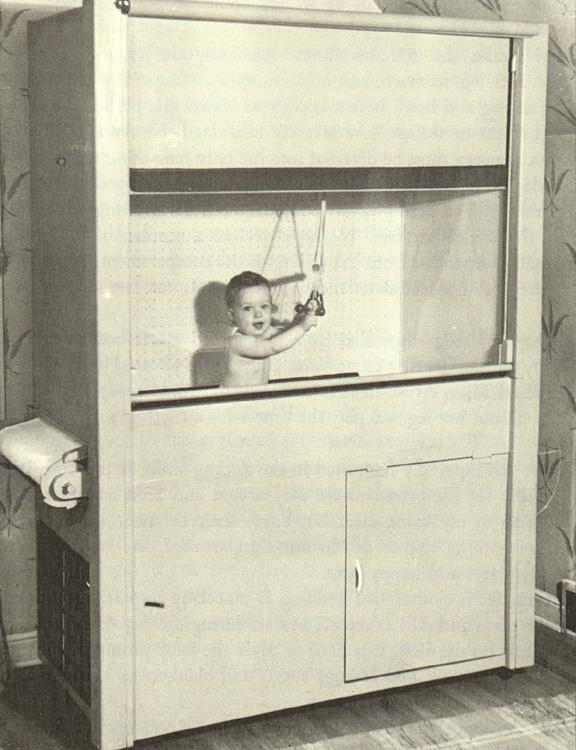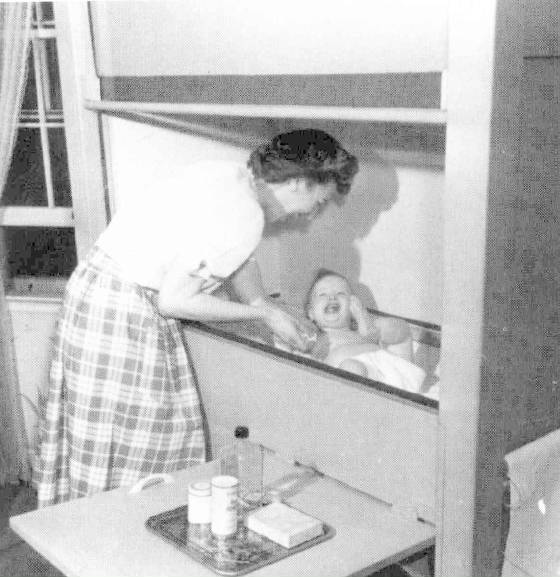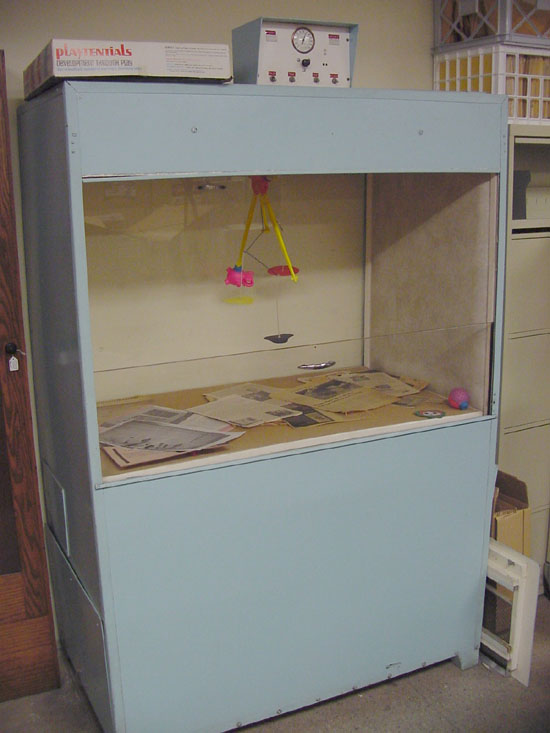BABY IN A BOX
B.F. Skinner
Ladies Home Journal,
October 1945



In that brave new world
which science is preparing for the housewife of the future, the young mother has
apparently been forgotten. Almost nothing has been done to ease her lot by
simplifying and improving the care of babies.
When we decided to have another child, my
wife and I felt that it was time to apply a little labor-saving invention and
design to the problems of the nursery. We began by going over the
disheartening schedule of the young mother, step by step. We asked only
one question: Is this practice important for the physical and
psychological health of the baby? When it was not, we marked it for
elimination. Then the “gadgeteering” began.
The result was an inexpensive apparatus in
which our baby daughter has now been living for eleven months. Her
remarkable good health and happiness and my wife’s welcome leisure have
exceeded our most optimistic predictions, and we are convinced that a new deal
for both mother and baby is at hand.
We tackled first the problem of warmth.
The usual solution is to wrap the baby in half-a-dozen layers of cloth-shirt,
nightdress, sheet, and blankets. This is never completely successful.
The baby is likely to be found steaming in its own fluids or lying cold and
uncovered. Schemes to prevent uncovering may be dangerous, and in fact
they have sometimes even proved fatal. Clothing and bedding also interfere
with normal exercise and growth and keep the baby from taking comfortable
postures or changing posture during sleep. They also encourage rashes and
sores. Nothing can be said for the system on the score of convenience,
because frequent changes and launderings are necessary.
Why not, we thought, dispense with
clothing altogether-except for the diaper, which serves another purpose-and warm
the space in which the baby lives? This should be a simple technical
problem in the modern home. Our solution is a closed compartment about as
spacious as a standard crib (Figure 1). The walls are well insulated, and
one side, which can be raised like a window, is a large pane of safety glass.
The heating is electrical, and special precautions have been taken to insure
accurate control.
After a little experimentation we found
that our baby, when first home from the hospital, was completely comfortable and
relaxed without benefit of clothing at about 86°F.
As she grew older, it was possible to lower the temperature by easy stages.
Now, at eleven months, we are operating at about 78°,
with a relative humidity of 50 per cent.
Raising or lowering the temperature by
more than a degree or two produces a surprising change in the baby’s condition
and behavior. This response is so sensitive that we wonder how a
comfortable temperature is ever reached with clothing and blankets.
The discovery, which pleased us most, was
that crying and fussing could always be stopped by slightly lowering the
temperature. During the first three months, it is true, the baby would
also cry when wet or hungry, but in that case she would stop when changed or
fed. During the past six months she has not cried at all except for a
moment or tow when injured or sharply distressed-for example, when inoculated.
The “lung exercise” which so often is appealed to reassure the mother of a
baby who cries a good deal takes the much pleasanter form of shouts and gurgles.
How much of this sustained cheerfulness is
due to the temperature is hard to say, because the baby enjoys many other kinds
of comfort. She sleeps in curious postures, not half of which would be
possible under securely fastened blankets.
When awake, she exercises almost
constantly and often with surprising violence. Her leg, stomach, and back
muscles are especially active and have become strong and hard. It is
necessary to watch this performance for only a few minutes to realize how
severely restrained the average baby is, and how much energy must be diverted
into the only remaining channel crying.
A wider range and variety of behavior are
also encouraged by the freedom from clothing. For example, our baby
acquitted an amusing, almost apelike skill in the use of her feet. We have
devised a number of toys, which are occasionally suspended from the ceiling of
the compartment. She often plays with these with her feet alone and with
her hands and feet in close cooperation.
One toy is a ring suspended from a
modified music box. A note can be played by pulling the ring downward, and
a series of rapid jerks will produce Three Blind Mice. At seven months our
baby would grasp the ring in her toes, stretch out her leg and play the tune
with a rhythmic movement of her foot.
We are not especially interested in
developing skills of this sort, but they are valuable for the baby because they
arouse and hold her interest. Many babies seem to cry from sheer
boredom-their behavior is restrained and they have nothing else to do. In
our compartment, the waking hours are invariably active and happy ones.
Freedom from clothes and bedding is
especially important for the older baby who plays and falls asleep off and on
during the day. Unless the mother is constantly on the alert, it is hard
to cover the baby promptly when it falls asleep and to remove and arrange sheets
and blankets as soon as it is ready to play. All this is now unnecessary.
Remember that these advantages for the
baby do not mean additional labor or attention on the part of the mother.
On the contrary, there is an almost unbelievable saving in time and effort.
For one thing, there is no bed to be made or changed. The “mattress”
is a tightly stretched canvas, which is kept dry by warm air. A single
bottom sheet operates like a roller towel.1 It is stored on a
spool outside the compartment at one end and passes into a wire hamper at the
other. It is ten yards long and lasts a week. A clean section can be
locked into place in a few seconds. The time which is usually spent in
changing clothes is also saved. This is especially important in the early
months. When we take the baby up for feeding or play, she is wrapped in a
small blanket or a simple nightdress. Occasionally she is dressed up
“for fun” or for her play period. But that is all. The wrapping
blanket, roller sheet, and the usual diapers are the only laundry actually
required.
1The canvas and “endless”
sheet arrangement was soon replaced with a single layer of woven plastic, which
would be cleaned and instantly wiped dry.
Time and labor are also saved because the
air which passes through the compartment is thoroughly filtered. The
baby’s eyes, ears, and nostrils remain fresh and clean. A weekly bath is
enough, provided the face and diaper region are frequently washed. These
little attentions are easy because the compartment is at waist level.
It takes about one and one-half hours each
day to feed, change, and otherwise care for the baby. This includes
everything except washing diapers and preparing formula. We are not
interested in reducing the time any further. As a baby grows older, it
needs a certain amount of social stimulation. And after all, when
unnecessary chores have been eliminated, taking care of a baby is fun.
An unforeseen dividend has been the
contribution to the baby’s good health. Our pediatrician readily
approved the plan before the baby was born, and he has followed the results
enthusiastically from month to month. Here are some points on the health
score: When the baby was only ten days old, we could place her in the
preferred face-down position without danger of smothering, and she has slept
that way ever since, with the usual advantages. She has always enjoyed
deep and extended sleep, and her feeding and eliminative habits have been
extraordinarily regular. She has never had a stomach upset, and she has
never missed a daily bowel movement.
The compartment is relatively free of
spray and air-borne infection, as well as dust and allergic substances.
Although there have been colds in the family, it has been easy to avoid
contagion, and the baby has completely escaped. The neighborhood children
troop in to see her, but they see her through glass and keep their school-age
diseases to themselves. She has never had a diaper rash.
We have also enjoyed the advantages of a
fixed daily routine. Child specialists are still not agreed as to whether
the mother should watch the baby or the clock, but no one denies that a strict
schedule saves time, for the mother can plan her day in advance and find time
for relaxation or freedom for other activities. The trouble is that a
routine acceptable to the baby often conflicts with the schedule of the
household. Our compartment helps out here in two ways. Even in
crowded living quarters it can be kept free of unwanted lights and sounds.
The insulated walls muffle all ordinary noises, and a curtain can be drawn down
over the window. The result is that, in the space taken by a standard
crib, the baby has in effect a separate room. We are never concerned lest
the doorbell, telephone, piano, or children at play wake the baby, and we can
therefore let her set up any routine she likes.
But a more interesting possibility is that
her routine may be changed to suit our convenience. A good example of this
occurred when we dropped her schedule from four to three meals per day.
The baby began to wake up in the morning about an hour before we wanted to feed
her. This annoying habit, once established, may persist for months.
However, by slightly raising the temperature during the night we were able to
postpone her demand for breakfast. The explanation is simple. The
evening meal is used by the baby mainly to keep herself warm during the night.
How long it lasts will depend in part upon how fast heat is absorbed by the
surrounding air.
One advantage not to be overlooked is that
the soundproofing also protects the family from the baby! Our intentions
in this direction were misunderstood by some of our friends. We were never
put to the test, because there was no crying to contend with, but it was never
our policy to use the compartment in order to let the baby “cry it out.”
Every effort should be made to discover
just why a baby cries. But if the condition cannot be remedied, there is
no reason why the family, and perhaps the neighborhood as well, must suffer.
(Such a compartment, by the way, might persuade many a landlord to drop a “no
babies” rule, since other tenants can be completely protected.)
Before the baby was born, when we were
still building the apparatus, some of the friends and acquaintances who had
heard about what we proposed to do were rather shocked. Mechanical
dish-washers, garbage disposers, air cleaners, and other laborsaving devices
were all very fine, but a mechanical baby tender - that was carrying science too
far! However, all the specific objections, which were raised against the
plan, have faded way in the bright light of our results. A very brief
acquaintance with the scheme in operation is enough to resolve all doubts.
Some of the toughest skeptics have become our most enthusiastic supporters.
One of the commonest objections was that
we were gong to raise a "softie” who would be unprepared for the real
world. But instead of becoming hypersensitive, our baby has acquired a
surprisingly serene tolerance for annoyances. She is not bothered by the
clothes she wears at playtime, she is not frightened by loud or sudden noises,
she is not frustrated by toys out of reach, and she takes a lot of pummeling
from her older sister like a good sport. It is possible that she will have
to learn to sleep in a noisy room, but adjustments of that sort are always
necessary. A tolerance for any annoyance can be built up by administering
it in controlled dosages, rather than in the usual accidental way.
Certainly there is no reason to annoy the child throughout the whole of its
infancy, merely to prepare it for later childhood.
It is not, of course, the favorable
conditions to which people object, but the fact that in our compartment they are
“artificial.” All of them occur naturally in one favorable environment
or another, where the same objection should apply but is never raised. It
is quite in the spirit of the “world of the future” to make favorable
conditions available everywhere through simple mechanical means.
A few critics have objected that they
would not like to live in such a compartment themselves-they feel that it would
stifle them or give them claustrophobia. The baby obviously does not share
in this opinion. The compartment is well ventilated and much more spacious
than a Pullman berth, considering the size of the occupant. The baby
cannot get out, of course, but that is true of a crib as well. There is
less actual restraint in the compartment because the baby is freer to move
about. The plain fact is that she is perfectly happy. She has never
tried to get out nor resisted being put back in, and that seems to be the final
test.
Another early objection was that the baby
would be socially starved and robbed of the affection and mother love, which she
needs. This has simply not been true. The compartment does not
ostracize the baby. The large window is no more of a social barrier than
the bars of a crib. The baby follows what is going on in the room, smiles
at passers-by, plays “peek-a-boo” games, and obviously delights in company.
And she is handled, talked to, and played with whenever she is changed or fed,
and each afternoon during a play period, which is becoming longer as she grows
older.
The fact is that a baby will probably get
more love and affection when it is easily cared for, because the mother is
likely to feel overworked and resentful of the demands made upon her. She
will express her love in a practical way and give the baby genuinely
affectionate care.
It is common practice to advise the
troubled mother to be patient and tender and to enjoy her baby. And, of
course, that is what any baby needs. But is is the exceptional mother who
can fill this prescription upon demand, especially if there are other children
in the family and she has no help. We need to go one step further and teat
the mother with affection also. Simplified childcare will give mother love
a chance.
A similar complaint was that such an
apparatus would encourage neglect. But easier care is sure to be better
care. The mother will resist the temptation to put the baby back into a
damp bed if she can conjure up a dry one in five seconds. She may very
well spend less time with her baby, but babies do not suffer from being left
alone but only from the discomforts, which arise from being, left alone in the
ordinary crib.
How long do we intend to keep the baby in
the compartment? The baby will answer that in time, but almost certainly
until she is two years old, or perhaps three. After the first year of
course, she will spend a fair part of each day in a playpen or out of doors.
The compartment takes the place of a crib and will get about the same use.
Eventually it will serve as sleeping quarters only.
We cannot, of course, guarantee that every
baby raised in this way will thrive so successfully. But there is a
plausible connection between health and happiness and the surroundings we have
provided, and I am quite sure that our success is not an accident. The
experiment should, of course, be repeated again and again with different babies
and different parents. One case is enough, however, to disprove the flat
assertion that it can’t be done. At least we have shown that a moderate
and inexpensive mechanization of baby care will yield a tremendous saving in
time and trouble, without harm to the child and probably to its lasting
advantage.





